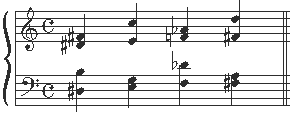|
CHROMATIC SCALES |
|
Chromatic scales and passages in moto contrario can be dealt with in different ways, according to the instrument's range.
In moto contrario it is better to use the position with the wrists turned inwards (4-3 right hand and 2-1 left hand), since this way you can reach better at the two extremes of the keyboard. The other possibilities are: wrists outwards wrists and mallets facing the same way to the left (if you are playing at the lower end), or wrists and mallets facing the same way to the right (if you are playing at the higher end). Always link one group of notes to another, without leaving gaps, and avoid unpleasant acciaccatura effects, or arpeggios, when playing double-note scales. In conclusion, it is only by analysing and trying and trying again the various movements to be accomplished for each type of fingering that you can get the exact best position to adopt in each exercise. As we have already stated earlier, it is essential not to limit yourself in doing scales to applying only the fingering marked in books. In conclusion, only by trying, retrying and analyzing the amplitude of the various movements to be performed, for each fingering, can one exactly establish the most advantageous position to adopt for each type of scale or exercise. The chromatic scales, as was noted, do not have tonalities and adapt to the combination of chords and harmonies that support them. Played in isolation, as technical exercises, however, they lose the tonality of the initial note. Chromatic scales at mixed intervals are, on the other hand, a true didactic discovery because, to the chromatic exercise, they combine the even more important one of opening and closing the mallets. |
